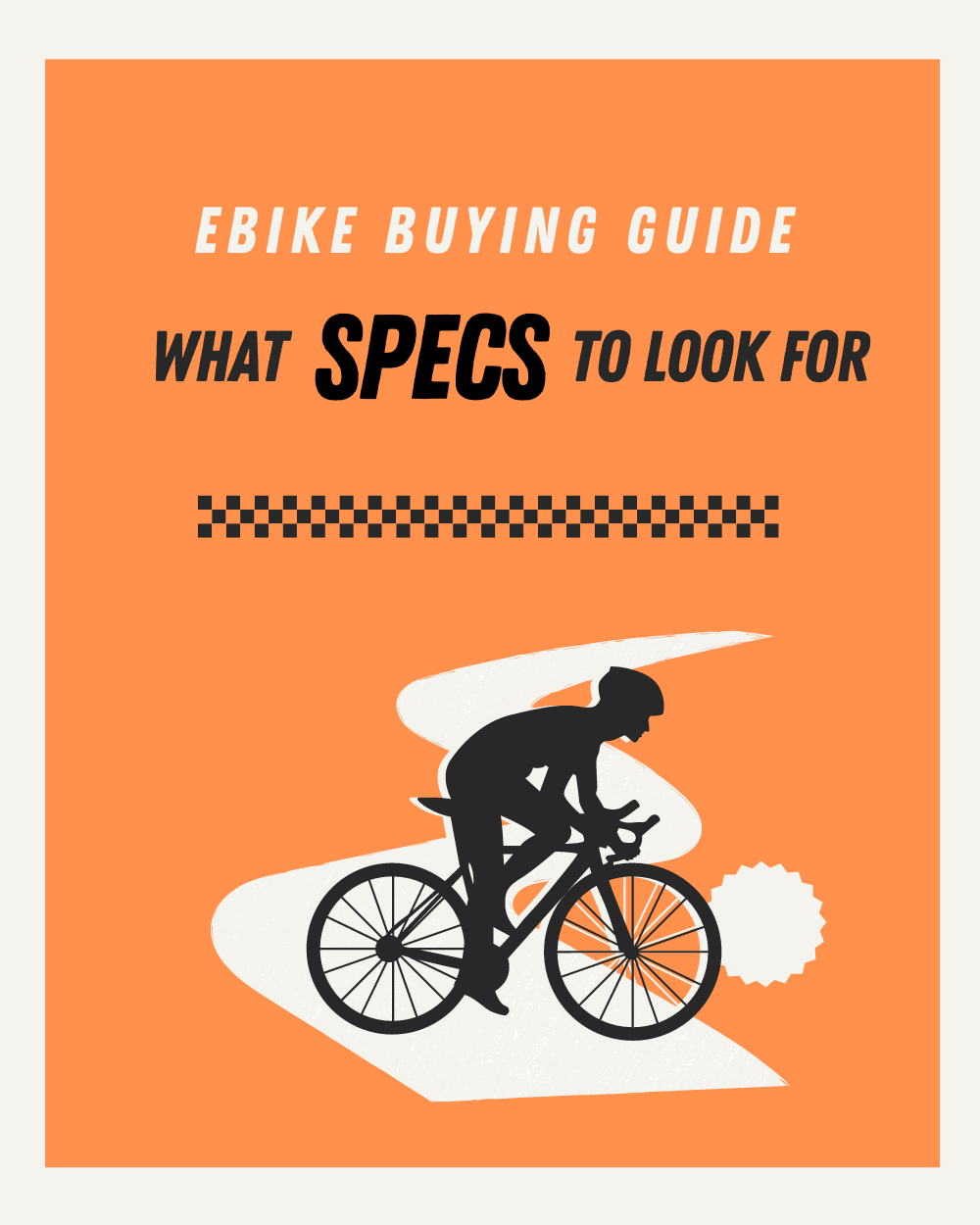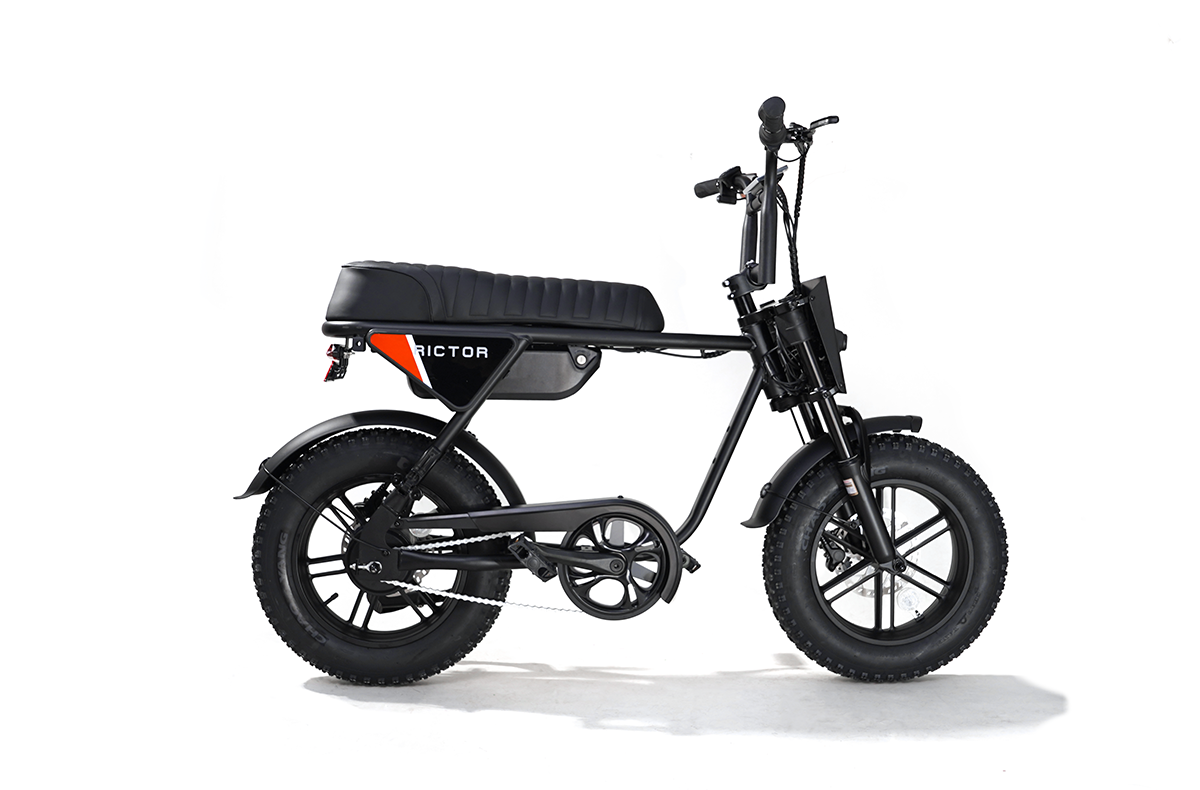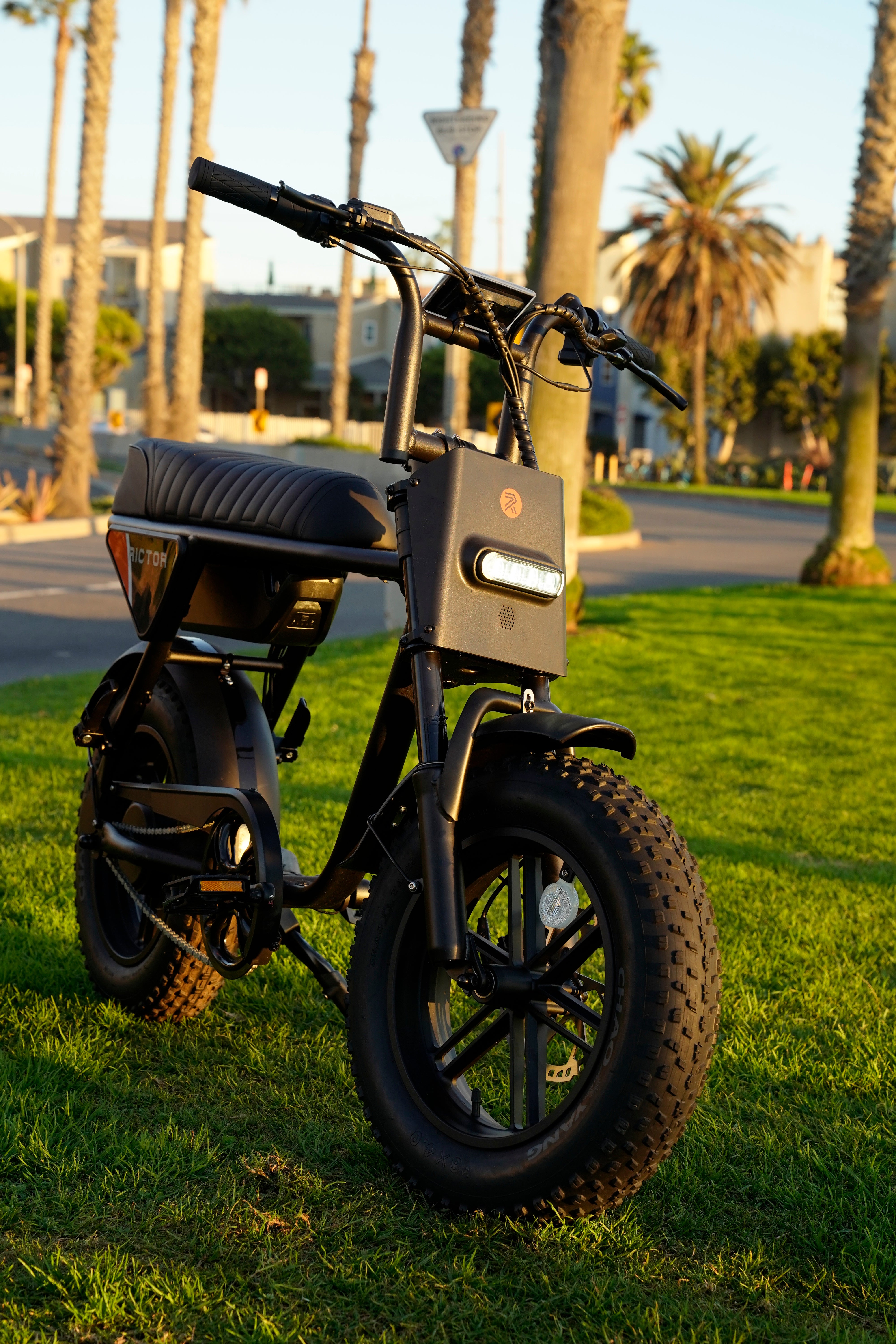
Ebike Buying Guide: What Specs to Look for
The market is brimming with diverse models, each tailored to specific needs—whether you're looking for commuting ease, off-road adventures, or something in between.
If you're investing in electric bikes, the specs you choose can make or break your riding experience.
To ensure you get the most bang for your buck, let’s break down the critical specifications you need to look for.
Motor Power: How Much is Enough?
One of the most important specs to evaluate in an eBike is motor power.
The motor provides the electric assist that powers your ride. Measured in watts (W), the motor’s power determines how much assistance you’ll get while pedaling.
For casual city commuting, a 250W to 500W motor will suffice.
These motors provide enough assistance to help you navigate city streets and moderate hills without breaking a sweat.
They are ideal for those who don’t need to reach high speeds and are riding mainly on flat, smooth surfaces.
This power range is typically what you’ll find in most entry-level to mid-range eBikes.
If you’re planning to tackle rough terrains, steep hills, or off-road paths, you’ll want something beefier—ideally a 750W or even 1000W motor. Rictor K1 is a high performance electric bike with 750w powerful motor. Half bike, half motorcycle, but truly a cultural hybrid. That is RICTOR. Check it now!
These higher powered motors deliver robust acceleration and the ability to handle tougher terrains with ease.
The extra wattage ensures that you can maintain consistent speed on uphill climbs and through rugged, uneven terrain.
Riders who are heavier or who carry cargo will also benefit from these more powerful motors, as they provide the necessary torque to handle additional weight.
-
250W-500W Motor: Ideal for commuting and light urban use, offering sufficient power to reach speeds of up to 20 mph.
-
750W-1000W Motor: Perfect for off-road trails, hilly terrain, and riders who want extra power to achieve higher speeds of 28 mph or more.
Hub Motor vs. Mid-Drive Motor
When looking at motor types, you’ll also need to choose between a hub motor or a mid-drive motor.
Hub motors are positioned in the front or rear wheel, and they’re great for simpler, more affordable eBikes.
These motors directly drive the wheel, making them easy to maintain, and they offer a smooth, quiet ride. Hub motors are less complex and can be ideal for urban commuters who don’t need the extra power efficiency of a mid-drive.
Mid-drive motors are located in the center of the bike and tend to offer better balance and power distribution, making them a top choice for performance riders.
They drive the bike’s chain, which allows for more efficient use of energy, especially when climbing hills.
Because the motor is positioned at the bike's center of gravity, mid-drive motors provide a more balanced feel, especially when navigating steep or tricky terrains.
They also allow you to take full advantage of the bike’s gears, delivering more efficient power output for those challenging rides.
-
Hub Motor: Cost-effective, simple, great for flat terrains, and usually found in lower-end models.
-
Mid Drive Motor: More efficient, better for hilly or off-road environments, offers better torque, and is typically found in higher-end eBikes designed for performance.
Battery Capacity: How Far Can You Go
The second key spec you’ll want to consider is the battery capacity, typically measured in ampere-hours (Ah) or watt-hours (Wh).
The larger the battery, the further you can ride on a single charge. Battery capacity directly affects your eBike’s range, which is how far you can travel before needing to recharge.
For most urban commuters, a 10Ah to 15Ah battery will provide sufficient range, roughly 30-50 miles depending on the level of assist and terrain.
For those seeking extended rides, whether it’s long-distance commuting or weekend adventures, a battery in the 15Ah to 20Ah range is more suitable.
These batteries can offer ranges of up to 70 miles or more under optimal conditions.
Some eBikes even come with dual battery setups, allowing you to double your range for longer rides without worrying about running out of power.
This is especially useful for riders who venture out on extended trips or use their bikes for touring purposes, where recharging stations might not be readily available.
The convenience of swapping or combining batteries ensures that your ride isn't cut short by a low battery.
-
10Ah-15Ah: Suitable for short commutes and casual rides (30-50 miles).
-
15Ah-20Ah: Ideal for long-distance rides or tougher terrains (up to 70 miles or more).
-
Dual Battery Option: Allows for extended range and convenience for adventure riders, with some setups pushing the range beyond 100 miles.
Charging Time
Battery capacity is important, but so is the charging time.
Most eBikes take between 4 to 6 hours to charge fully, but some models with fast-charging capabilities can reduce this time to 3 hours or less.
Always check whether the bike comes with a standard charger or an optional fast charger if you need to minimize downtime between rides.
Fast chargers can be a game-changer for those who rely on their eBikes daily or need to charge quickly between long rides.
Frame Material: Durability vs. Weight
The frame of your eBike is another crucial spec that affects both durability and comfort.
Most eBikes are made from either aluminum alloy, carbon fiber, or steel. Each material offers different advantages, and your choice will largely depend on how and where you plan to ride.
-
Aluminum Alloy: The most common eBike frame material due to its excellent balance between weight and strength. It’s lightweight, rust-resistant, and affordable. Aluminum frames are perfect for urban riders who need a durable yet light frame that’s easy to maneuver.
-
Carbon Fiber: Known for being extremely lightweight and strong, carbon fiber is the go-to choice for premium eBikes, especially those built for speed and performance. However, it tends to be more expensive, making it a choice for performance enthusiasts or serious riders who value weight savings and efficiency.
-
Steel: Heavier than aluminum or carbon fiber but incredibly durable. Steel frames provide a smooth ride and are ideal for riders who value comfort over speed. Steel’s flexibility makes it great for absorbing road vibrations, but its added weight can be a drawback for those who need speed or a lighter bike for carrying and storage.
For city commuting, an aluminum frame will likely meet your needs.
If you’re into performance biking or longer rides, you may want to invest in carbon fiber for a lightweight, fast, and more agile ride.
Steel is an excellent option for those who prioritize durability and comfort, particularly for rough terrains or daily long-distance riding.
Tire Size: What’s Your Terrain?
Tires play a significant role in the comfort and versatility of your ride.
Tire size can range from 20 inches to 29 inches depending on your riding style and terrain. The tires you choose should align with the type of riding you plan to do most often.
For urban or road use, narrow tires (26-28 inches) offer faster speeds and less rolling resistance.
These tires are perfect for paved streets and smooth surfaces. They allow for easier acceleration, better handling, and increased efficiency on city roads.
For riders planning on off-roading, fat tires (around 20 inches with widths of 3.5 to 4.8 inches) are ideal.
Fat tires provide increased traction and stability, especially on uneven terrain like gravel, sand, or snow.
They also absorb bumps and shocks much better, giving you a smoother ride on rough surfaces.
These tires are essential for adventurous riders who want the flexibility to explore off-road paths, trails, or unpredictable terrains.
-
Narrow Tires (26-28 inches): Perfect for city riding and smooth surfaces, offering higher speeds and efficiency.
-
Fat Tires (20 inches, 3.5-4.8 inches wide): Best for off-road adventures, trails, and rugged terrains, providing increased traction and comfort.
Brakes: Safety First
When it comes to brakes, safety is paramount. eBikes typically come with either mechanical disc brakes or hydraulic disc brakes.
Both types offer reliable stopping power, but hydraulic brakes are generally more efficient and require less hand effort, making them the superior option for those who ride at higher speeds or on tougher terrains.
-
Mechanical Disc Brakes: Affordable and offer reliable stopping power. These brakes use cables to pull the brake pads, providing solid control and easy maintenance. However, they require more effort and can wear down faster over time.
-
Hydraulic Disc Brakes: More powerful, require less maintenance, and provide smoother, more consistent braking, especially in wet conditions. These brakes use hydraulic fluid to transfer force to the brake pads, making them more responsive and requiring less hand strength. They are ideal for riders who demand top-tier performance, especially in adverse weather or downhill descents.
If you’re planning to ride in varied weather conditions or need the extra assurance of quick stopping power, hydraulic disc brakes are a must.
The smoother control and reduced hand fatigue make them perfect for longer rides and rougher terrain.
Suspension: Comfort on All Terrain
Your suspension system is essential for ensuring a smooth ride, particularly on bumpy roads or trails.
There are two main types of suspension to consider: front suspension (also called a hardtail) and full suspension.
Choosing between these two depends largely on the type of terrain you'll be riding on and how much comfort you prioritize.
Front Suspension
This is common in urban or commuter bikes where the primary goal is to absorb small bumps and cracks in the road.
The front fork absorbs shock from the front wheel, which significantly improves comfort on uneven surfaces.
Front suspension is ideal for riders who mainly travel on city streets, paved bike paths, or lightly uneven terrains.
It’s also lighter and generally more affordable than full suspension, making it a great choice for city commuters and casual riders.
Full Suspension
It provides shock absorption for both the front and rear of the bike, which is critical when riding on more rugged terrains like mountain trails or off-road paths.
With full suspension, both the front fork and rear shock are designed to absorb large impacts, delivering superior comfort and control when navigating rocks, roots, or uneven ground.
This feature is a must for anyone planning to do serious off-road riding, offering greater traction and reducing fatigue during long rides.
However, full suspension bikes are typically heavier and more expensive, but they offer the smoothest ride possible on challenging terrain.
For everyday city commuting, front suspension might be all you need, while adventure seekers who enjoy tackling rocky trails and rugged landscapes will benefit from the enhanced comfort of full suspension.
Gearing System: Versatility in Speed
An often-overlooked spec in eBikes is the gearing system.
While the motor provides power, the gears allow you to adapt that power to different terrains. More gears mean more flexibility in adjusting your effort and speed based on the riding conditions.
A well-designed gearing system ensures that you’re pedaling efficiently, no matter if you’re cruising on a flat surface or climbing a steep hill.
-
Single Speed Bikes: Great for flat roads and short distances, single-speed bikes offer simplicity and require less maintenance. These bikes are ideal for city riders who don’t need to switch between gears often and prefer a straightforward, low-maintenance ride.
-
7 Speed to 9 Speed Bikes: If you plan on riding through varied terrains or tackling hills, a 7-speed or 9-speed gear system is essential. With multiple gears, you can easily adjust the resistance and speed, making it easier to ride uphill or through challenging conditions. The more gears you have, the more fine-tuned control you’ll have over your riding experience, especially when paired with a powerful motor that assists your pedaling.
For commuters, a 7 speed gearing system is often enough, offering versatility without overcomplicating the ride.
However, if you’re a more serious rider or planning on doing a lot of varied terrain, a 9-speed system might give you the flexibility you need.
Pedal Assist vs. Throttle Control
Two of the main features that define how you interact with your eBike are pedal assist and throttle control. Both options offer different ways of using the bike’s motor to help you ride with less effort.
Pedal Assist
Pedal assist is a feature that automatically activates the motor when you pedal. Depending on the assist level you choose, the motor will provide varying degrees of power to make pedaling easier.
On a low assist setting, you might only get a small boost, while a high assist setting will make it feel like you're barely pedaling at all.
This feature still encourages you to pedal and can provide a good workout, while reducing fatigue on long rides or steep climbs.
Throttle Control
Throttle control lets you power the motor without pedaling at all, similar to how a motorcycle throttle works.
You can engage the motor with a twist of the handlebar or push of a button, allowing the bike to do all the work.
This is perfect for times when you need a break from pedaling or when you want to quickly accelerate from a standstill, like at a stoplight.
However, relying on throttle control can drain the battery faster than pedal assist, so it’s something to consider if you want to maximize your range.
Many eBikes come equipped with both pedal assist and throttle control, giving you the flexibility to switch between the two depending on your needs.
If you prefer a traditional biking experience with an occasional boost, pedal assist is ideal. For riders who want a more relaxed, low-effort experience, throttle control provides a more laid-back way of riding.
Lights and Accessories
Integrated LED lights increase visibility, especially for those who plan on riding at night or during low-light conditions.
Front and rear lights are essential for urban commuters who navigate through traffic, ensuring that you’re easily seen by drivers and pedestrians.
Additionally, many eBikes come with optional fenders to keep you clean and dry in wet conditions, as well as racks for carrying groceries or luggage.
These practical accessories make your eBike even more versatile and useful for daily commuting or errands.
Smart Dashboards
Some high-end eBikes feature a smart dashboard that allows you to monitor your speed, battery life, mileage, and even access features like navigation. These integrated systems keep you informed about your ride and help you plan your trips more efficiently.
Smartphone Mounts
For those who rely on navigation or apps during their ride, a smartphone mount is a practical accessory. This mount allows you to easily view your phone’s screen for directions, music, or performance data.
The right set of accessories can turn a great eBike into an exceptional one, offering you more control, safety, and convenience.
Conclusion
Based on the key specs above, you can confidently choose the right eBike that matches your riding style, needs, and terrain preferences. For a versatile, high-performance option that excels in all these areas, explore the Rictor K1—designed to elevate your ride on any terrain.
FAQs
How often should I service my electric bike?
It’s recommended to service your eBike every 6-12 months, depending on how frequently you ride. Regular maintenance should include checking the brakes, battery, motor, and drivetrain to ensure everything is functioning smoothly.
How much weight can an Bike carry?
The weight limit varies by model, but most eBikes can carry between 250 to 350 pounds, including the rider and any additional cargo. Be sure to check the manufacturer's specifications to ensure the bike meets your needs.
How long does an electric bike battery last before needing replacement?
On average, an eBike battery lasts between 3 to 5 years with regular use. The lifespan depends on how often you charge it, riding conditions, and how well the battery is maintained. Regularly keeping the battery charged and avoiding extreme temperatures can extend its life.
💡 Explore More Here!
- Quick Gearshift Tips! Easy Guide for Beginners on 7 Speed Bikes
- Is Riding an E-bike Cheating? Or Is It the Ultimate Hack?
- Your handy checklist for buying a new e-bike, don't miss your best bike
- 2024 Electric Bicycle Pricing, don’t overpay on your next ride [+ Good Recommendation]
- How Much Does an Electric Bike Cost? Build Your Own or Buy New?



